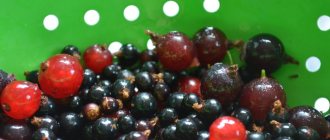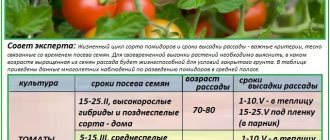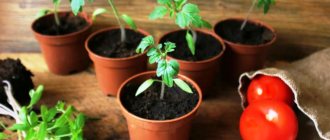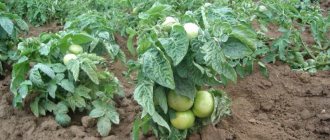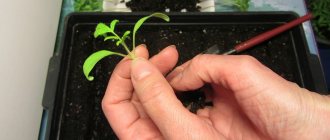Vegetable growing » Tomatoes
0
1695
Article rating
Kira Stoletova
Tomato is one of the most common crops. Successful cultivation of a vegetable depends on the quality of the soil in which it grows. Soil for tomatoes is characterized by many indicators. Each of them affects the taste, appearance and yield of the crop. Let's look at what kind of soil tomatoes like.
Soil for tomatoes
Soil acidity
The ideal soil for tomatoes is drained, loose, rich in organic matter. The plant likes neutral or slightly acidic soil, but not acidic. Acidity should be within ph7. If this norm is not observed, the seeds may not germinate. Check the soil like this:
- use a ready-made test or regular litmus paper;
- take some soil and pour 9% vinegar on it; if there is a lot of foaming, the soil is alkaline; if there is moderate foaming, it’s neutral; if there is no foam, it’s acidic.
If the soil is acidic, apply liming. Lime can be added both in autumn and spring. The lime must not be slaked. Add at the rate of 1-1.5 kg per 1 m2, digging up a layer of earth to a depth of 20 cm.
Pros and cons of ready-made land for sale
Not everyone has the opportunity to prepare the soil themselves. In this case, they use purchased soil (you can find out how to choose the best ready-made soil for seedlings of tomatoes and peppers here). It has undeniable advantages:
if it is prepared according to all the rules, it is immediately ready for use;- various packaging from 1 l to 50 l;
- it is light and moisture-resistant;
- contains the necessary elements.
Among its disadvantages:
- wide range of soil acidity indication (from 5.0 to 6.5);
- inaccurate indication of the amount of microelements;
- the composition may contain peat dust instead of peat;
- there is a risk of getting a low-quality substrate.
Mineral composition of the soil
For stable growth and development, the plant needs phosphorus, potassium and nitrogen. Fertilizers based on these elements are the key to a good harvest. The plant reacts to a lack of such nutrition by appearance:
- with a lack of nitrogen, the leaves are pale green, thin, small;
- phosphorus deficiency is manifested by red-violet leaves, plant growth and fruit formation slows down;
- with a lack of potassium, a bronze-colored border appears on the leaves;
- with insufficient calcium content (oxidation), the growing point and the top of the plant die.
To improve the mineral composition of the soil, use a bacterial cocktail. The solution contains a certain set of bacteria. They process nitrogen contained in the soil.
Tatyana Orlova (candidate of agricultural sciences):
Bacteria do not process nitrogen, but process plant residues contained in the soil, decomposing them to their elementary components - nitrogen, phosphorus, potassium. There are also nitrogen-fixing bacteria that can absorb nitrogen in the air and accumulate it in the soil.
You can buy it at any gardening store. The contents of 1 ampoule are used to treat 600 m2 of land.
What ingredients should you avoid?
When preparing soil for growing tomato seedlings, you must not:
- Take land near industrial facilities, roads and landfills. It contains harmful compounds and impurities.
- Add clay and loam to the composition. They degrade mechanical properties. They make the finished soil heavier and more viscous.
- Use fresh organic matter. For example, poorly rotted manure. It contains a large number of pathogenic microorganisms and weed seeds.
Rotted manure
Soil for seedlings
For sowing seeds, store-bought soil, peat, black soil and substrates are used.
Store soil
When choosing store-bought soil, pay attention to acidity and friability. The soil for tomatoes should be fluffy, dry, and not sticky. Ready-made mixtures already contain all the necessary components, but it is advisable to treat it with a solution of phytolavine, at the rate of 2 ml per 1 liter of water.
Peat
The most popular soil for tomatoes is peat. The peat content in it is about 80%. Peat is porous and allows air and moisture to pass through well. You need to add a little lime to it, 10 g per 1 kg of mixture, to neutralize the acidity.
Tatyana Orlova (candidate of agricultural sciences):
It is necessary to deoxidize the soil for seedlings in advance. This should not be done immediately before sowing seeds or planting seedlings. For a chemical reaction to take place, a certain soil moisture is needed (at least 65-70%).
You can transplant grown seedlings into chernozem
Chernozem
Chernozem is also suitable for tomatoes. It contains all the necessary substances for the normal development of plants. But it is not used as soil for seedlings. Chernozem is characterized by high density and an excess of nutrients. Seeds have difficulty germinating. It is best used for preparing mixtures for transplanting grown seedlings.
Substrates
It is best to use seedling substrates as soil for tomato seedlings. When preparing your own substrate, use light soil for tomatoes. Lightness is regulated by sand. Sand can be replaced with dry moss, coconut chips, and sawdust.
Substrates are recommended to be made according to the following recipes:
- take one part of peat and coconut fiber, half of the earth, humus, vermiculite, a little lime;
- take one part of sand, sawdust or husk, half of humus;
- vermiculite, peat and perlite in equal quantities;
- the same amount of earth, humus and compost, 300g of ash, 3 tbsp. spoons of superphosphate, 1 tablespoon of potassium sulfate;
- mix one part of peat turf, humus and add a little ash.
Humus can be replaced with purchased vermicompost. Peat is replaced with a peat-based mixture or sapropel - silty sediment of a fresh water body.
It is better to grow seedlings in a mixture of sawdust and sand in a ratio of 2 to 1. It is better to take sawdust from deciduous trees. They are sifted and soaked in a solution of mineral fertilizers. It is advisable to use stale sawdust; otherwise, boil them with boiling water, squeeze out and dry, increasing the flowability.
Tatyana Orlova (candidate of agricultural sciences):
Sand for making the soil mixture also needs a certain type. The best is washed coarse-grained river. Ordinary quarry sand - the result of marine sediments - contains salts or ferrous forms of iron. It can only be used after repeated rinsing with water.
Preparing the mixture
Start preparing the mixture in the fall. Store the prepared soil in the cold. Frost will kill diseases and pests in the soil.
If the mixture is prepared in the spring, then use the following recommendations:
- “fry” in the oven for an hour at 180˚C;
- steam for 30 minutes.
Tatyana Orlova (candidate of agricultural sciences):
It is not advisable to “fry” the soil, because this also kills all positive microflora. It is better to steam the soil for a short time, heating it to 60-70 degrees, essentially pasteurizing the soil, similar to the pasteurization of milk or other products.
How to prepare substrate at home with your own hands
The tomato is originally a southern vegetable, brought to Europe from hot countries, where this heat-loving and sun-loving plant did not need careful care. The climate of central Russia requires attention to soil components and their balance.
Seedling soil for tomatoes must have a multi-component composition: using ordinary soil from a greenhouse instead of a balanced composition will most likely lead to the seedlings stretching out, turning pale and becoming unviable. Tomatoes have a developed root system, so the soil should be conducive to its growth: it should be loose enough and retain moisture well; it is also recommended to carry out pre-sowing preparation of seeds.
Preparing homemade soil mixture
Preparing the substrate at home has advantages and disadvantages. One of the advantages is the ability to accurately maintain proportions, which is suitable for tomato seedlings that are demanding on the soil composition. In addition, soil for seedlings made independently is cheap. This material will tell you about growing onions.
By making the soil mixture yourself, the gardener reduces the risk of placing seedlings in overly acidic peat soil (it is often used as a basis in ready-made mixtures).
But making a homemade soil mixture is not without its drawbacks. Among them:
- time spent searching for all the necessary components and actually preparing the mixture;
- risk of using contaminated soil;
- forced precision in following the recipe.
However, many experienced gardeners believe that homemade substrate is preferable to buying ready-made mixtures.
Acidity level
Beef tomatoes, like any other varieties, require soil with an acidity of 6.2 to 6.8 pH. Soil with insufficient or excessive acidity not only prevents the proper development of seedlings, but also provokes diseases: clubroot, blackleg. You can check the acidity level of the soil using reagents, measuring instruments, and folk remedies.
Litmus test
The reagent consists of strips of paper with litmus applied to them. To test the soil, samples are taken from different beds. Each sample is wrapped in three layers of gauze and immersed in distilled water. The liquid in the container is shaken, after which a litmus strip is lowered into it. After the reaction occurs (change in the color of the litmus paper), the acidity level is determined according to the instructions included with the reagent. Read about the most productive varieties of cucumbers for open ground and greenhouses here.
Chalk
To determine the acidity level you should take:
- soil for analysis - 2 tbsp. l.;
- water at room temperature - 5 tbsp. l.;
- chalk - 1 tsp.
The components are mixed and placed in a bottle, onto the neck of which a fingertip is placed (the fingertip must first be squeezed to release the air from it).
Soil acidity level table.
If the soil does not have enough lime in its composition, a chemical reaction will begin, resulting in the release of carbon dioxide. This will straighten the fingertip. If the soil reaction is slightly acidic, the fingertip will straighten halfway, and if it is neutral, it will not straighten.
Alyamovsky device
It is a set of reagents that allows you to analyze water and salt extracts of the earth. Instructions for use are similar to using litmus paper.
Meter
It is a multifunctional device for analyzing and monitoring soil parameters. It measures not only its acidity, but also temperature, humidity and light. Read about tall varieties of tomatoes for greenhouses in this article.
Vinegar or hydrochloric acid
A small amount of garden soil is watered with strongly diluted vinegar (hydrochloric acid). If bubbles appear on the soil, its pH level is regarded as optimal; if not, lime is added to the soil.
Grape juice
A little earth is dropped into a glass of grape juice. If the liquid changes color and bubbles form on its surface and remain for a long time, it means that the acidity of the soil is neutral.
Soil disinfection
Seedling soil needs to be cleansed from pathogens of plant diseases. Three methods are used to disinfect it.
- Freezing.
- Treatment with a solution of potassium permanganate (3 g of potassium permanganate per 10 liters of water).
- Steaming the soil in a water bath for 45 minutes.
Instead of steaming, calcination of the soil in the oven is often used. The method is effective for disinfecting the soil, but there is a risk that with harsh heat treatment it will lose the beneficial substances it contains.
Site preparation
Before planting tomatoes, the ground must be prepared. The area for tomatoes is prepared in the fall. When preparing, follow a few rules:
- take care of good lighting of the area;
- the soil should be loose and nutritious;
- the bed cannot be placed in the same place every year;
- do not plant in place after vegetables of the nightshade family;
- It is better to plant them in beds after pumpkin vegetables, cabbage, legumes, onions, and carrots.
If you did not have time to cultivate the area in the fall, then in the spring, before placing the tomatoes in depleted soil, treat the soil with saltpeter in addition to other fertilizers. Apply fertilizers to the soil very carefully, according to the instructions.
An excess of minerals and organic matter harms plants more than their deficiency. They stop bearing fruit and increase their green mass.
The value of the nutrient medium
A high-quality earthen mixture determines abundant fruiting . If it turns out to be not good enough, the tomatoes will turn out to be sick and weak.
You can’t just use garden soil or soil from a greenhouse; it’s very likely that nothing will come of it. It is safer to purchase soil from the best producers in the store or prepare it yourself.
The soil for tomato seedlings is prepared from several components that require appropriate preparation. Tomatoes have a branched superficial root system, 70% consisting of suction roots. This structure provides the above-ground part of the plant with the necessary moisture and nutrients.
Soil for tomatoes
The soil needs to be prepared
Once the planting site has been decided, the soil is dug up to a depth of 20 cm and fertilizers are added. The following procedures are also carried out:
- if the soil is acidic, liming is done;
- if it is clay, then per 1 m2 they add: 10 kg of coarse sand, 5 kg of peat, 5 kg of compost;
- sandy soil is enriched with chernozem, humus or compost at the rate of 10 kg per 1 m2.
These activities improve the soil structure.
In the spring, the site is dug up again, humus, peat, manure, and microelements are added. Composition per 1m2: 30g of nitroammophos, 20g of ammonium sulfate, potassium magnesium, potassium sulphide. Then the area is dug up again without turning the layer to a depth of 30 cm.
Turf
The best soil for tomatoes is meadow or forest turf. They need to stock up in advance, in summer or autumn. The turf is laid out in a dark place in layers: about 10 cm high and about 25 cm wide. The layers are laid on top of each other with the grass surfaces inward. It is recommended to put humus between the layers. This soil for tomatoes can be used as early as next year.
You can make the following solution from turf: 1 bucket of turf, 1 tablespoon of wood ash, 1 tablespoon of superphosphate, 1 tablespoon of potassium sulfate. All this is mixed and left for a week. The day before use, the mixture is treated with a weak solution of manganese.
Tatyana Orlova (candidate of agricultural sciences):
It would be more correct to say that the best soil for tomatoes is not turf, but turf soil. These are different concepts. Turf soil, like compost from plant residues, takes about 1.5-2 years to prepare. During this time, the plant residues in the turf are overheated, and to speed up this process, the layers of turf are mixed and watered from time to time.
Using garden soil: pros and cons
It is believed that if garden soil is included in the soil mixture for growing seedlings as one of the components, tomatoes will better tolerate transplantation into open ground.
Garden soil after growing nightshades on it (where garlic, cabbage, beets and carrots grew) is not taken. Purchased land is generally cleaner than garden land (this is the minus of garden land) in terms of the content of weeds and possible diseases.
Soil from your garden is used if it is crumbly and structured. The advantage of garden soil is that it often has a good mechanical composition.
Warm bed
Anyone who wants to get their harvest early can make a warm bed for tomatoes. It has a number of advantages over conventional soil:
- the earth warms up earlier due to decomposing organic matter;
- it does not need to be dug up in the spring;
- the plant is initially provided with all useful substances.
First, a trench is dug, the depth of which is 40 cm. Thick polyethylene is placed on the sides. A layer of branches and twigs, paper, cardboard, newspapers, again bush branches, cut grass and collected leaves from the area are laid out at the bottom. A layer of soil is poured, then a layer of manure is laid out and the soil itself on which the plant will grow, its layer should be approximately 30 cm. The bed is watered with water and covered with straw or agrofibre. In the spring, when the frosts disappear, the bed quickly warms up. Therefore, tomatoes are planted in such soil earlier.
The best mixture to choose for planting tomatoes
The soil mixture should be porous, loose and not too acidic . It should include the following components:
- Humus.
- Peat (increases moisture supply and looseness of the soil).
- Leavening agents (except for peat, this is coarse river sand).
- Leaf soil (mixed with other types of soil, since it has great looseness, but a small amount of nutrients).
The prepared soil mixture is disinfected with a solution of potassium permanganate.
What to look for when purchasing
If a person is new to gardening, there will be some problems with the purchase. To prevent this from happening, before going to the store you should remember or write down 5 recommendations.
- Universal option or specialized. We pay attention to this parameter first of all, since when purchasing a universal copy, auxiliary additives should be selected. When choosing a specialized option, it is taken into account what it is intended for and used only for its intended purpose.
- Compound. When purchasing a quality product, the packaging always contains information about acidity, substances contained, etc. The mixture is packaged in special bags. Also, the composition often indicates which plants the product is suitable for. If there is no information, it is not recommended to buy the mixture, since nothing will be known about it.
- Some gardeners check the chemical composition directly in the store. It must contain at least 4 components; if the value is lower, then it is not a fact that the plant will take root. It is also taken into account that one of the components should be peat or sand, because this tells the buyer about the looseness of the mixture. We must not forget about minerals; without them, the quality of the soil will not be inferior to garden soil, so the purchase will become pointless.
- If a person plans to purchase a large amount of soil, it is not recommended to buy it in bulk at once. First, buy one sachet. The looseness, how well water flows, the structure of the mixture, etc. are assessed. If the product meets all the criteria, you can begin bulk purchasing.
- If you have no experience working with soil, you can evaluate its quality in a specialized laboratory. However, it is recommended to do this only for people with a large garden plot or when purchasing certain soil for greenhouse plants that will subsequently be sold. In other cases it will not be justified.
